What We’re Reading: April 7th
Note: See Why We’re Writing “What We’re Reading”
Review: Ammonium as a signal for physiological and morphological responses ($)
 Ammonium is one of the major forms in which nitrogen is assimilated. Besides being a nutrient, it also acts as signal that affects gene expression and root system architecture. Some ammonium-induced genes are also induced by low pH (ammonium acidifies the apoplast), whereas others are specifically induced by ammonium or its assimilation products (e.g., glutamine). Liu and von Wirén review the molecular components of ammonium signaling, which include the AMT ammonium transporters/transceptors. Although many components have been identified, many gaps in our understanding remain and are discussed. J Exp. Bot. 10.1093/jxb/erx086 Tags: Gene Regulation, Physiology, Signals and Responses, Transport
Ammonium is one of the major forms in which nitrogen is assimilated. Besides being a nutrient, it also acts as signal that affects gene expression and root system architecture. Some ammonium-induced genes are also induced by low pH (ammonium acidifies the apoplast), whereas others are specifically induced by ammonium or its assimilation products (e.g., glutamine). Liu and von Wirén review the molecular components of ammonium signaling, which include the AMT ammonium transporters/transceptors. Although many components have been identified, many gaps in our understanding remain and are discussed. J Exp. Bot. 10.1093/jxb/erx086 Tags: Gene Regulation, Physiology, Signals and Responses, Transport
Review: Root branching plasticity: collective decision-making results from local and global signalling
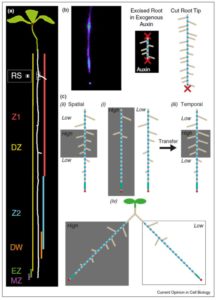 Roots are extraordinary examples of developmental plasticity, and hundreds of papers have reported on the mechanisms by which root system architecture responds to the environment and the global nutritional status of the plant. McCleery et al. propose a model that synthesizes evidence of intrinsic, local and long-distance signals. They suggest that the root system is best represented as a set of rhizomers (analogous to the phytomers that compose the shoot system), and that each rhizomer perceives and processes input (including hormones, peptides, miRNAs, and nutrients) to promote or suppress its developmental journey to lateral root emergence. Curr. Opin. Cell Biol. 10.1016/j.ceb.2017.03.001 Tags: Development, Systems Biology
Roots are extraordinary examples of developmental plasticity, and hundreds of papers have reported on the mechanisms by which root system architecture responds to the environment and the global nutritional status of the plant. McCleery et al. propose a model that synthesizes evidence of intrinsic, local and long-distance signals. They suggest that the root system is best represented as a set of rhizomers (analogous to the phytomers that compose the shoot system), and that each rhizomer perceives and processes input (including hormones, peptides, miRNAs, and nutrients) to promote or suppress its developmental journey to lateral root emergence. Curr. Opin. Cell Biol. 10.1016/j.ceb.2017.03.001 Tags: Development, Systems Biology
Review: Secrets of succulence ($)
 “Succulence is a phenomenon that has long eluded a decisive consensus definition,” begins Males in his review of the physiology and evolutionary developmental biology of succulence. Succulence can broadly be defined as the storage of water such that the plant can maintain physiological activity in the absence of an external supply (in other words, drought avoidance), but where and how this water is stored is highly variable. Furthermore, succulence has evolved many times independently, so the trait of succulence is quite diverse. The author describes the variables that affect the physiology of succulent water use, which include specialized cells and tissues, short-lived roots, and the dynamic regulation of aquaporins, as well as efforts to map these traits to genes, and the “complex relationship” between succulence and CAM, the specialized form of photosynthesis found in many but not all succulent plants. J. Exp. Bot. 10.1093/jxb/erx096 Tags: Botany, Ecophysiology, Physiology
“Succulence is a phenomenon that has long eluded a decisive consensus definition,” begins Males in his review of the physiology and evolutionary developmental biology of succulence. Succulence can broadly be defined as the storage of water such that the plant can maintain physiological activity in the absence of an external supply (in other words, drought avoidance), but where and how this water is stored is highly variable. Furthermore, succulence has evolved many times independently, so the trait of succulence is quite diverse. The author describes the variables that affect the physiology of succulent water use, which include specialized cells and tissues, short-lived roots, and the dynamic regulation of aquaporins, as well as efforts to map these traits to genes, and the “complex relationship” between succulence and CAM, the specialized form of photosynthesis found in many but not all succulent plants. J. Exp. Bot. 10.1093/jxb/erx096 Tags: Botany, Ecophysiology, Physiology
Perspective: Research priorities for harnessing plant microbiomes in sustainable agriculture
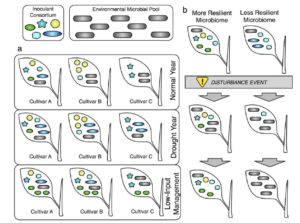 Beneficial microbes help plants take up nutrients, confer protection against pathogens, and can even affect flowering time. Busby et al. argue for a coordinated effort between researchers and farmers to study plant microbiomes with the goal of using them to enhance productivity. The authors define and describe five research priorities: 1. Develop model host–microbiome systems for crop plants and non-crop plants with associated microbial culture collections and reference genomes, 2. Define core microbiomes and metagenomes in model host–microbiome systems, 3. Elucidate the rules of synthetic, functionally programmable microbiome assembly, 4. Determine functional mechanisms of plant–microbiome interactions, 5. Characterize and refine plant genotype-by-environment-by-microbiome-by-management interactions. Each of these priorities is described further in the article. PLOS Biol. 10.1371/journal.pbio.2001793 Tags: Applied Plant Biology, Biotic Interactions
Beneficial microbes help plants take up nutrients, confer protection against pathogens, and can even affect flowering time. Busby et al. argue for a coordinated effort between researchers and farmers to study plant microbiomes with the goal of using them to enhance productivity. The authors define and describe five research priorities: 1. Develop model host–microbiome systems for crop plants and non-crop plants with associated microbial culture collections and reference genomes, 2. Define core microbiomes and metagenomes in model host–microbiome systems, 3. Elucidate the rules of synthetic, functionally programmable microbiome assembly, 4. Determine functional mechanisms of plant–microbiome interactions, 5. Characterize and refine plant genotype-by-environment-by-microbiome-by-management interactions. Each of these priorities is described further in the article. PLOS Biol. 10.1371/journal.pbio.2001793 Tags: Applied Plant Biology, Biotic Interactions
Update: Stomatal defense a decade later
 Stomatal defense, recognition of pathogens at the stomatal pore accompanied by stomatal closure to prevent their entry, was discovered ten years ago. Melotto et al. review what we’ve learned in the past decade about this key defense strategy. They discuss pathogen recognition, in which microbe-associated molecular patterns (MAMPs) are perceived by pattern recognition receptors (PRRs); downstream signaling including the contributions of ABA, salicylates and jasmonates; and the channels that mediate stomatal closure. They also review strategies by which pathogens are able to evade or suppress stomatal defenses, and the impact of environmental conditions on stomatal defenses. Plant Physol. 10.1104/pp.17.00183 Tags: Biotic Interactions, Signals and Responses
Stomatal defense, recognition of pathogens at the stomatal pore accompanied by stomatal closure to prevent their entry, was discovered ten years ago. Melotto et al. review what we’ve learned in the past decade about this key defense strategy. They discuss pathogen recognition, in which microbe-associated molecular patterns (MAMPs) are perceived by pattern recognition receptors (PRRs); downstream signaling including the contributions of ABA, salicylates and jasmonates; and the channels that mediate stomatal closure. They also review strategies by which pathogens are able to evade or suppress stomatal defenses, and the impact of environmental conditions on stomatal defenses. Plant Physol. 10.1104/pp.17.00183 Tags: Biotic Interactions, Signals and Responses
Live Confocal Imaging of Developing Arabidopsis Flowers
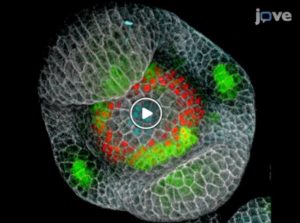 Monitoring cells and their activities in real time provides exceptional insights into their mechanisms and strategies of growth. Prunet has used live confocal imaging of Arabidopsis flowers to study the placement of floral organs and the dynamics of floral stem cells. Here, he presents a detailed protocol for live confocal imaging of developing Arabidopsis flowers. The included video will help new imagers learn the fine points of this powerful method. JOVE 10.3791/55156 Tags: Cell Biology, Development
Monitoring cells and their activities in real time provides exceptional insights into their mechanisms and strategies of growth. Prunet has used live confocal imaging of Arabidopsis flowers to study the placement of floral organs and the dynamics of floral stem cells. Here, he presents a detailed protocol for live confocal imaging of developing Arabidopsis flowers. The included video will help new imagers learn the fine points of this powerful method. JOVE 10.3791/55156 Tags: Cell Biology, Development
Salicylic acid interferes with GFP fluorescence in vivo
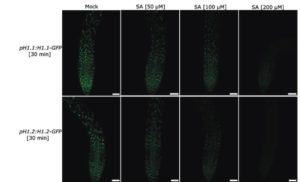 Green Fluorescent Protein (GFP) is a widely-used reporter with which to analyze protein localization and expression levels. De Jonge et al. report that GFP fluorescence is greatly diminished in the presence of the hormone salicylic acid (SA), as is the fluorescence of the reporters RFP and VENUS. The reduction of fluorescence is observed with many different promoters, suggesting that it not due to transcriptional effects. Furthermore, the protein level is not affected by SA, indicating again that it is not due to expression-level effects. Finally, the authors showed that the fluorescence in vitro is unaffected by SA, which suggests that the fluorescence reduction requires as yet undetermined cellular components. Until this effect is understood, it is a good idea to be cautious when using GFP or other similar markers in the presence of SA. J. Exp. Bot. 10.1093/jxb/erx031 Tags: Cell Biology, Signals and Responses
Green Fluorescent Protein (GFP) is a widely-used reporter with which to analyze protein localization and expression levels. De Jonge et al. report that GFP fluorescence is greatly diminished in the presence of the hormone salicylic acid (SA), as is the fluorescence of the reporters RFP and VENUS. The reduction of fluorescence is observed with many different promoters, suggesting that it not due to transcriptional effects. Furthermore, the protein level is not affected by SA, indicating again that it is not due to expression-level effects. Finally, the authors showed that the fluorescence in vitro is unaffected by SA, which suggests that the fluorescence reduction requires as yet undetermined cellular components. Until this effect is understood, it is a good idea to be cautious when using GFP or other similar markers in the presence of SA. J. Exp. Bot. 10.1093/jxb/erx031 Tags: Cell Biology, Signals and Responses
Mutations in Argonaute5 illuminate epistatic interactions of the K1 and I loci leading to saddle seed color patterns in Glycine max ($)
 Classic studies revealed an interesting genetic relationship between two loci that control pigmentation in soybeans seeds. Dominant alleles of the I locus suppress pigmentation through the production of small interfering RNAs that target chalcone synthase RNA (an enzyme involved in pigment production). Other I alleles including ii and ik lead to partially pigmented seeds. The effect of the I alleles are epistatically suppressed by the k1 allele. Cho et al. show that the K1 locus encodes Argonaute5, a protein involved in siRNA-mediated silencing. The k1 allele has a small deletion in the AGO5 gene that restricts the ability of I-locus derived siRNAs to suppress pigment synthesis. As always, the identification of the molecular basis for a classically-defined genetic anomaly makes for an interesting paper to read with students. Plant Cell 10.1105/tpc.17.00162 Tags: Education and Outreach, Gene Regulation, Genetics
Classic studies revealed an interesting genetic relationship between two loci that control pigmentation in soybeans seeds. Dominant alleles of the I locus suppress pigmentation through the production of small interfering RNAs that target chalcone synthase RNA (an enzyme involved in pigment production). Other I alleles including ii and ik lead to partially pigmented seeds. The effect of the I alleles are epistatically suppressed by the k1 allele. Cho et al. show that the K1 locus encodes Argonaute5, a protein involved in siRNA-mediated silencing. The k1 allele has a small deletion in the AGO5 gene that restricts the ability of I-locus derived siRNAs to suppress pigment synthesis. As always, the identification of the molecular basis for a classically-defined genetic anomaly makes for an interesting paper to read with students. Plant Cell 10.1105/tpc.17.00162 Tags: Education and Outreach, Gene Regulation, Genetics
Diversity of CO2 concentrating mechanisms and responses to CO2 concentration in marine and freshwater diatoms ($)
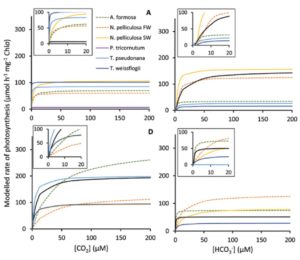 The CO2-fixing enzyme ribulose bisphosphate carboxylase (Rubisco) works most efficiently at high concentrations of CO2. Many organisms have evolved CO2-concentrating mechanisms (CCMs), such as the PEP-carboxylation that occurs upstream of Rubisco in C4 plants. Diatoms and other eukaryotic algae use a biophysical mechanism involving transporters of CO2 or HCO3– produced by carbonic anhydrase through the reaction CO2 + H2O ↔ H2CO3 ↔ HCO3– + H+. Clement et al. investigated CO2 fixation and CO2-concentrating mechanisms in fresh-water and marine diatoms acclimated to varying pH and CO2 levels. Key findings include no indication of C4-type CCMs in the diatoms they studied, and no clear differences between marine and fresh-water species, in spite of the fact that CO2-levels are much more variable in fresh water. J Exp. Bot. 10.1093/jxb/erx035 Tags: Botany, Biochemistry, Bioenergetics, Metabolism
The CO2-fixing enzyme ribulose bisphosphate carboxylase (Rubisco) works most efficiently at high concentrations of CO2. Many organisms have evolved CO2-concentrating mechanisms (CCMs), such as the PEP-carboxylation that occurs upstream of Rubisco in C4 plants. Diatoms and other eukaryotic algae use a biophysical mechanism involving transporters of CO2 or HCO3– produced by carbonic anhydrase through the reaction CO2 + H2O ↔ H2CO3 ↔ HCO3– + H+. Clement et al. investigated CO2 fixation and CO2-concentrating mechanisms in fresh-water and marine diatoms acclimated to varying pH and CO2 levels. Key findings include no indication of C4-type CCMs in the diatoms they studied, and no clear differences between marine and fresh-water species, in spite of the fact that CO2-levels are much more variable in fresh water. J Exp. Bot. 10.1093/jxb/erx035 Tags: Botany, Biochemistry, Bioenergetics, Metabolism
A chloroplast envelope glycolate transporter and its involvement in photorespiratory metabolism
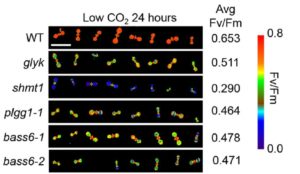 In C3 plants at ambient CO2 levels, Rubisco’s oxygenation reaction occurs about once for every three carboxylation reactions. One of the oxygenation products, 2-phosphoglycolate, is rapidly dephosphorylated to glycolate which is toxic and inhibitory to photosynthesis. Glycolate has to be removed from the chloroplast for its subsequent metabolism. South et al. carried out a reverse genetics screen of genes that had been identified as encoding chloroplast membrane transporters. They found that a T-DNA insertion of the BASS6 gene leads to a photorespiratory mutant phenotype, and that the BASS6 protein encodes a glycolate transporter. This work can contribute to efforts to re-engineer plants to recycle glycolate more efficiently. Plant Cell 10.1105/tpc.16.00775 Tags: Bioenergetics, Genetics, Transport
In C3 plants at ambient CO2 levels, Rubisco’s oxygenation reaction occurs about once for every three carboxylation reactions. One of the oxygenation products, 2-phosphoglycolate, is rapidly dephosphorylated to glycolate which is toxic and inhibitory to photosynthesis. Glycolate has to be removed from the chloroplast for its subsequent metabolism. South et al. carried out a reverse genetics screen of genes that had been identified as encoding chloroplast membrane transporters. They found that a T-DNA insertion of the BASS6 gene leads to a photorespiratory mutant phenotype, and that the BASS6 protein encodes a glycolate transporter. This work can contribute to efforts to re-engineer plants to recycle glycolate more efficiently. Plant Cell 10.1105/tpc.16.00775 Tags: Bioenergetics, Genetics, Transport
Symplastic communication spatially directs local auxin biosynthesis to maintain root stem cell niche in Arabidopsis ($)
 Although plant cells are surrounded by walls, cytoplasmic strands connect adjacent cells through junctions called plasmodesmata. Liu et al. investigated the contributions of plasmodesmata to signaling between root quiescent center (QC) cells and the cells that surround the QC by expression of an inducible gene for callose production in the QC cells. Callose is a polysaccharide that blocks plasmodesmata and is usually produced following wounding or infection to prevent the spread of pathogens or damage. The authors show that blocking symplastic communication disrupted auxin biosynthesis, formation of an auxin gradient, and stem cell maintenance. Proc. Natl. Acad. Sci. USA 10.1073/pnas.1616387114 Tags: Cell Biology, Development, Signals and Responses
Although plant cells are surrounded by walls, cytoplasmic strands connect adjacent cells through junctions called plasmodesmata. Liu et al. investigated the contributions of plasmodesmata to signaling between root quiescent center (QC) cells and the cells that surround the QC by expression of an inducible gene for callose production in the QC cells. Callose is a polysaccharide that blocks plasmodesmata and is usually produced following wounding or infection to prevent the spread of pathogens or damage. The authors show that blocking symplastic communication disrupted auxin biosynthesis, formation of an auxin gradient, and stem cell maintenance. Proc. Natl. Acad. Sci. USA 10.1073/pnas.1616387114 Tags: Cell Biology, Development, Signals and Responses
BRC1 expression regulates bud activation potential, but is not necessary or sufficient for bud growth inhibition in Arabidopsis
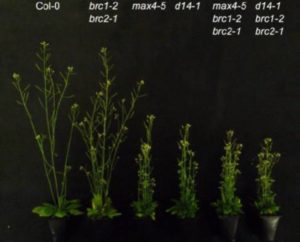 Shoot branching patterns are determined by whether lateral buds are activated or inhibited. Classic studies showed that auxin transport both in the stem and from the bud affects bud outgrowth, and more recent studies have demonstrated a role for strigolactones in regulating bud outgrowth, probably through effects on auxin transport. Genetic studies in both maize and Arabidopsis point to specific transcription factors including BRANCHED1 (BRC1) as inhibiting branch outgrowth. Seale et al. explored the contribution of BRC1 to bud inhibition and conclude that it is likely to act in parallel with auxin-transport, rather than acting as a downstream integrator or switch of hormonal signals. Development 10.1242/dev.145649 Tags: Development, Growth Regulation, Signals and Responses
Shoot branching patterns are determined by whether lateral buds are activated or inhibited. Classic studies showed that auxin transport both in the stem and from the bud affects bud outgrowth, and more recent studies have demonstrated a role for strigolactones in regulating bud outgrowth, probably through effects on auxin transport. Genetic studies in both maize and Arabidopsis point to specific transcription factors including BRANCHED1 (BRC1) as inhibiting branch outgrowth. Seale et al. explored the contribution of BRC1 to bud inhibition and conclude that it is likely to act in parallel with auxin-transport, rather than acting as a downstream integrator or switch of hormonal signals. Development 10.1242/dev.145649 Tags: Development, Growth Regulation, Signals and Responses
Better understanding how plant roots breathe under water ($)
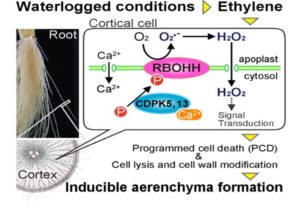 Waterlogging, a process by which water saturates soil, results in oxygen-deficient soil conditions and can result in massive crop loss. In order for plants to survive in waterlogged soil, shoots transport oxygen to roots through lysigenous aerenchyma, a specialized tissue type formed by ethylene-induced programed cell death. Using molecular and biochemical methods, Yamauchi et al. report that the rice response to aneroboic soil conditions involves: (i) ethylene induced expression of the NADPH oxidase, RESPIRATORY BURST OXIDASE HOMOLOG (RBOHH) and (ii) calcium-dependent kinase (CDPK) activation of RBOHH, which then produces ROS to signal cell death and subsequently the formation of lysigenous aerenchyma in rice roots. These findings may help us to tailor strategies to enhance plant survival in waterlogged conditions. Future studies include identifying more components that function in this process. (Summary by Tyra McCray). Plant Cell 10.1105/tpc.16.00976 Tags: Abiotic Interactions, Biochemistry, Cell Biology, Signals and Responses
Waterlogging, a process by which water saturates soil, results in oxygen-deficient soil conditions and can result in massive crop loss. In order for plants to survive in waterlogged soil, shoots transport oxygen to roots through lysigenous aerenchyma, a specialized tissue type formed by ethylene-induced programed cell death. Using molecular and biochemical methods, Yamauchi et al. report that the rice response to aneroboic soil conditions involves: (i) ethylene induced expression of the NADPH oxidase, RESPIRATORY BURST OXIDASE HOMOLOG (RBOHH) and (ii) calcium-dependent kinase (CDPK) activation of RBOHH, which then produces ROS to signal cell death and subsequently the formation of lysigenous aerenchyma in rice roots. These findings may help us to tailor strategies to enhance plant survival in waterlogged conditions. Future studies include identifying more components that function in this process. (Summary by Tyra McCray). Plant Cell 10.1105/tpc.16.00976 Tags: Abiotic Interactions, Biochemistry, Cell Biology, Signals and Responses
Covariation and phenotypic integration in chemical communication displays ($)
 Humans aren’t very sophisticated at reading chemical communication cues. Towards deciphering the information content of complex chemical mixtures produced by plants and animals, Junker et al. ask to what extent chemical communication displays (CCDs) are replicated between samples and individuals. The first finding is that covariation (similarity in the blends) is higher in samples produced by animals to communicate within their own species (e.g., pheromones) than those produced by plants to communicate with one or more other species (e.g., attractant and alarm cues). This suggests that in plant displays much of the crucial information is conveyed by the presence of one or a few compounds, whereas in animal displays information is conveyed by ratios between multiple compounds. Furthermore, biosynthetically-related compounds are over-represented in plant displays, suggesting that some compounds may simply be by-products of the production of the important information cue. New Phytol. 10.1111/nph.14505 Tags: Biochemistry, Biotic Interactions, Environmental Plant Biology
Humans aren’t very sophisticated at reading chemical communication cues. Towards deciphering the information content of complex chemical mixtures produced by plants and animals, Junker et al. ask to what extent chemical communication displays (CCDs) are replicated between samples and individuals. The first finding is that covariation (similarity in the blends) is higher in samples produced by animals to communicate within their own species (e.g., pheromones) than those produced by plants to communicate with one or more other species (e.g., attractant and alarm cues). This suggests that in plant displays much of the crucial information is conveyed by the presence of one or a few compounds, whereas in animal displays information is conveyed by ratios between multiple compounds. Furthermore, biosynthetically-related compounds are over-represented in plant displays, suggesting that some compounds may simply be by-products of the production of the important information cue. New Phytol. 10.1111/nph.14505 Tags: Biochemistry, Biotic Interactions, Environmental Plant Biology
Groundwater depletion embedded in international food trade ($)
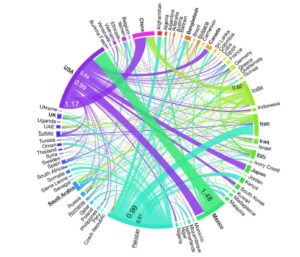 Many food-producing regions rely on the withdrawal of water from non-renewable underground sources, a condition called groundwater depletion for irrigation (GWD). Globally, GWD increased by 22% between 2000 and 2010. When food produced with GWD is exported, the exporting country is essentially exporting its non-renewable water resources. Dalin et al. analyzed regional and crop-specific GWD data to identify areas of concern. Major “water” exporters are the US (particularly California), Pakistan, and India, with China a major importer. The five crops that contribute most to GWD are wheat, rice, sugar crops, cotton and maize. Nature 10.1038/nature21403 Tags: Abiotic Interactions, Applied Plant Biology, Ecophysiology
Many food-producing regions rely on the withdrawal of water from non-renewable underground sources, a condition called groundwater depletion for irrigation (GWD). Globally, GWD increased by 22% between 2000 and 2010. When food produced with GWD is exported, the exporting country is essentially exporting its non-renewable water resources. Dalin et al. analyzed regional and crop-specific GWD data to identify areas of concern. Major “water” exporters are the US (particularly California), Pakistan, and India, with China a major importer. The five crops that contribute most to GWD are wheat, rice, sugar crops, cotton and maize. Nature 10.1038/nature21403 Tags: Abiotic Interactions, Applied Plant Biology, Ecophysiology
Could plants be sentient?
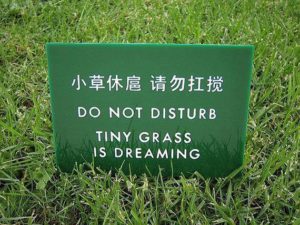 Sentience, the capacity to feel subjectively, is considered limited to organisms that have a nervous system and a centralized brain. Plants, therefore, have been excluded from this group based on: lack of a transmission mechanism like the animal nervous system; lack of a brain; simplicity; and inability to run away from a threat or to forage. Calvo et al. try to debunk these concepts one by one in this preprint that may be considered more of a philosophical essay. From explaining how the phloem can be considered phytoneurons to how signals are perceived and transmitted through the vascular system, and responses prioritized by the plant, this ideas presented in this manuscript are very well worth pondering. (Summary by Gaby Auge) bioRxiv. 10.1101/121731 Tags: Abiotic Interactions, Botany, Evolution, Signals and Responses
Sentience, the capacity to feel subjectively, is considered limited to organisms that have a nervous system and a centralized brain. Plants, therefore, have been excluded from this group based on: lack of a transmission mechanism like the animal nervous system; lack of a brain; simplicity; and inability to run away from a threat or to forage. Calvo et al. try to debunk these concepts one by one in this preprint that may be considered more of a philosophical essay. From explaining how the phloem can be considered phytoneurons to how signals are perceived and transmitted through the vascular system, and responses prioritized by the plant, this ideas presented in this manuscript are very well worth pondering. (Summary by Gaby Auge) bioRxiv. 10.1101/121731 Tags: Abiotic Interactions, Botany, Evolution, Signals and Responses




Leave a Reply
Want to join the discussion?Feel free to contribute!